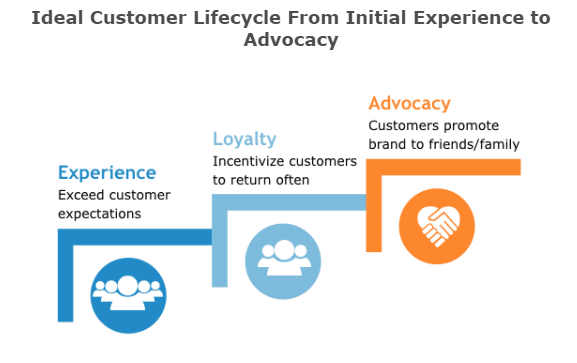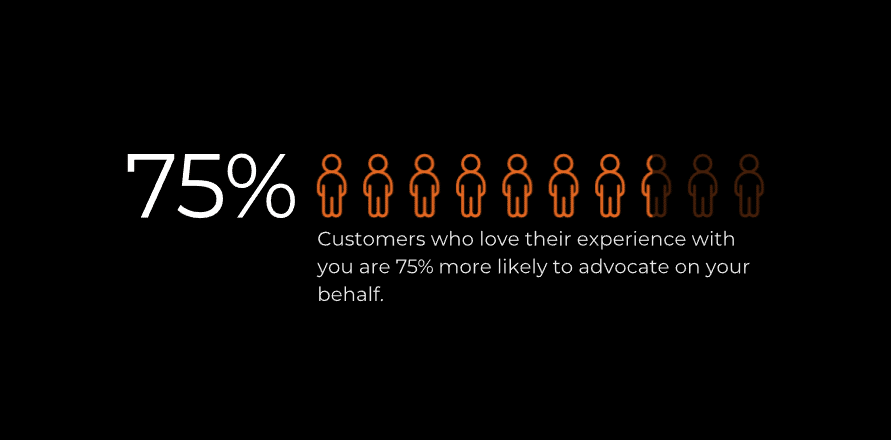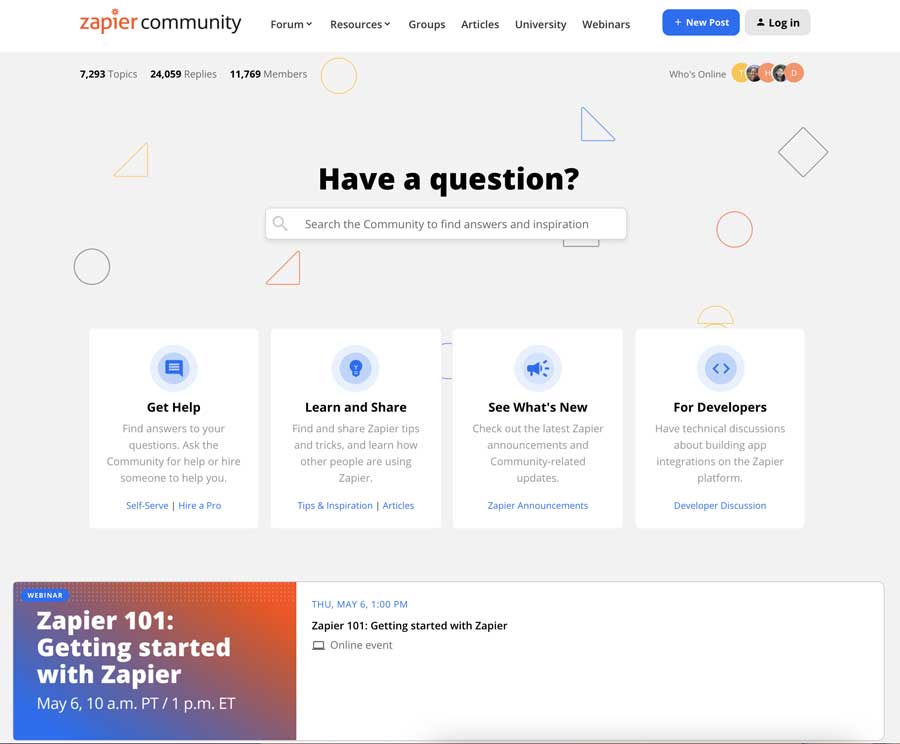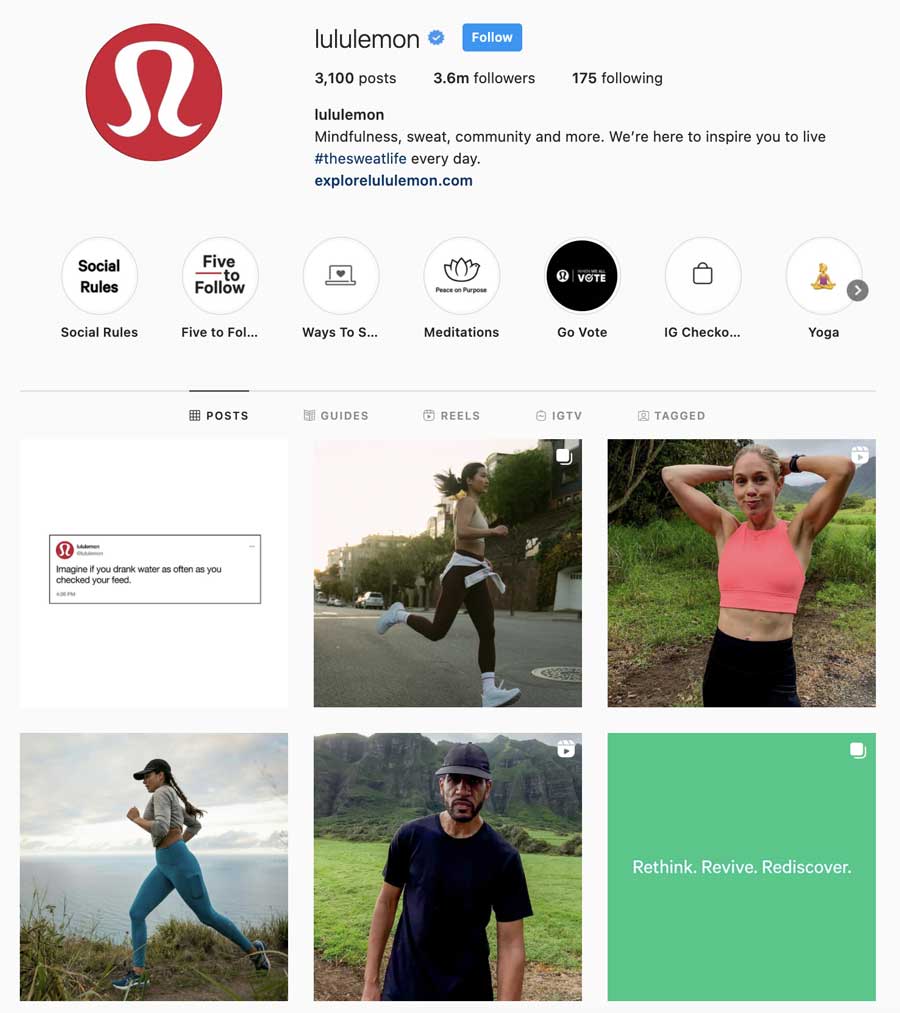When does someone go from being a loyal customer to an advocate? Customer advocacy is an advanced strategy that differs for every industry. It’s also one that’s becoming more and more important, as customers will go out of their way to buy from companies that offer a better experience.
In today’s competitive world, customer advocacy looks at what matters most to your business – satisfied customers.
A customer advocacy strategy is a high-level plan that requires in-depth knowledge and insight into what turns customers who buy into customers who actively advocate and promote your business.
To learn more about this difference, we look to a customer advocacy strategy.
What does “customer advocacy” actually mean?
Customer advocacy is the active focus and prioritization of customer needs within your business. It’s closely tied to customer support, customer success, and customer experience – all which are part of an overall customer-centric mindset.
As opposed to being company- or products-centric, customer advocacy is a “put customers first” way of doing business.
It looks for new ways to elevate customer experience and satisfaction, whether that means answering all support tickets within an hour or recommending another plan (even if it brings in less profit).
As a result of this customer-centric mindset, you’ll create customers who not only keep coming back to purchase from you, but also can’t help but tell their friends about what you have to offer.
Why customer advocacy is important
A recent study reveals only 12% of people believe when a company says “we put the customer first.”
To make matters worse, a whopping 42% of companies don’t actually conduct any customer surveys or collect feedback.
What does this mean? Companies claim to put customers first, but many don’t put it into practice. And customers know it.
These days, customers are more informed and empowered than ever before. They readily share their experiences online, and do research before making a purchase (especially for B2Bs).
And with so many brands competing for attention, the power shifts to the customer.
This is what makes customer advocacy so important. By focusing on your customer’s needs, they’re more likely to stay loyal and share your brand with others.
Plus, it ensures all your future initiatives, whether it’s a new product, service, or campaign, are aligned with customer demand.
Neglect your customer base, however, and sales will dwindle.
Know what your customers really think
Customer advocacy naturally comes with a deeper understanding of your audience. By taking the time to listen and actively improve your customer experience, you’ll discover a wealth of insights.
- What really matters to them?
- How do they rate their overall experience?
- What do they like best about your product?
- Where do they experience any confusion or friction?
- What added features would they like to see?
- Are there any areas where you’re falling short of expectations?
Communicate with your customers, and you’ll get a much clearer picture of what your market wants and where you need to invest more resources.
Generate better customer relationships and reviews
In time, you’ll find that engaging with your customers leads to long-term, trusted relationships. You’ll experience higher customer retention rates and increased customer lifetime value.
Even beyond your business, you’ll see a growth in brand awareness, online reputation, and positive customer reviews.
Reviews are one of the best ways to gauge how your business is doing – both now and in the future.
- 93% of people say online reviews influence their decision to purchase
- 72% of people will only consider a product after reading a positive review
- 92% of B2B buyers are more likely to purchase after reading a positive review
- 94% of people avoid businesses with negative reviews (usually, anything lower than three or four stars)
- People are willing to pay up to 31% more for businesses with positive reviews
As you can see, positive reviews and recommendations play a major role in driving customers to your business.
And the difference between getting a positive or negative review? A customer advocacy strategy.
Building a customer advocacy strategy
In a perfect world, customers would instantly love your brand and customer advocacy would just happen.
In reality, you need to put a strategy in place to see customer advocacy success. With so many things going on with a business (product development, operations, marketing, etc.), checking on your customers can easily fall to the wayside. Customer advocacy strategies prevent this from happening.
A customer advocacy strategy is a plan of action to focus on customer needs and satisfaction within a company. It looks at every touchpoint, from first customer contact to after-sales support, and uses these insights to help achieve business goals and growth.
Here are a few popular ways to measure customer advocacy:
- Net promoter score (NPS) survey
- Customer feedback surveys
- Third-party review sites (e.g., Yelp, TrustRadius, Foursquare)
- Brand mentions on social media
- Referrals and word of mouth (whether organic or as a channel)
- Measuring customer retention rates
- Measuring customer lifetime value (CLV)
You’re already communicating in various ways. But by integrating customer feedback into your overall strategy, you get direct insight into what the market thinks about your business. You know exactly what to do to create happy customers, which leads to better relationships and brand reputation.
Step 1: Determine a goal for your customer advocacy strategy
As with all business strategies, it’s important to have a goal. What does customer advocacy success look like for your business? It could be increasing the number of positive reviews, getting more referrals, or receiving higher NPS scores. Whatever you’re hoping to achieve with your customer advocacy strategy, it’s best if you have a way to measure success.
How about a goal for your advocates? You may get a better idea after some initial feedback, but a few examples could be more available access to customer communities, better self-service options, or more referral program channels.
Remember: This is a customer advocacy strategy. So it’s important to put your advocates’ goals before your own company’s goals.
Step 2: Appoint a customer advocate
Customer advocates are the individuals or team assigned to prioritize your customer needs within the company. They’re in charge of ringing all customer data under one customer advocacy strategy, and represent the “voice of customer.” In other words, they are your customer’s advocate.
Customer advocacy vs. brand advocacy: Customer advocates are often confused with brand advocates. Brand advocates are your biggest fans, and actively use and promote your product to others. Read our in-depth article covering brand advocates.
What do customer advocates do? This depends on your industry and company. But generally speaking, customer advocates:
- Study points of contact between the company and its customers
- Conduct customer satisfaction surveys and collect feedback
- Analyze and empathize with customer needs, concerns, and views of success
- Identify all areas of improvement throughout customer experience
- Routinely track and measure customer satisfaction levels
- Tie together all customer advocacy efforts, including loyalty programs, referral programs, or affiliate programs
- Plan and execute customer advocacy strategy in alignment with the company’s greater goals
While advocacy should be infused into every part of your company (or else it will seem inauthentic), having an appointed customer advocate will help streamline and standardize your entire customer advocacy strategy.
How do you find customer advocates?
Successful customer advocates require a wide skill set. They need to have a firm grasp of your company’s strategy and vision, but are also public-facing. The need to empathize with customers, but track all the touch points and create actionable insights.
Whether you decide to hire someone specifically to manage your customer advocacy strategy, or transition an existing team member, here are a few things to look for in a customer advocate:
- Understanding of your business goals and vision
- Comfortable working with cross-functional teams
- Empathetic and trustworthy
- Skilled at handling difficult situations
- Can read the data and form actionable strategies
- Able to manage programs and campaigns
- Able to pinpoint any problem areas and spearhead new initiatives to fix them
Step 3: Create a customer experience they won’t forget
Think of your last great experience as a customer. Odds are, it didn’t involve anything monetary.
Great customer experiences go beyond the expected transactions. They’re about connection and emotion. Below, we go over four proven ways to build a positive experience for customers:
- Creating online communities
- Actively engaging customers
- Look for ways to delight your customers
- Empower your employees on customer service
Building an online customer community
Individuals instinctively gravitate toward like-minded groups and communities: Online through forums and group platforms, offline within clubs or team activities.
Why not build a community around your customers? There are five notable benefits of a community:
- Shared knowledge
- Deeper connection
- Creative inspiration
- Pool of resources
- Personalized support
Customer communities can be more general or topic-focused. They can ride on existing social media platforms (i.e., Facebook groups, Slack channels) or custom-built using online community software. Here are a few examples of successful customer communities:
- Zapier’s community is almost 12,000 members strong, and revolves around learning and sharing answers with existing platform users
- Ethereum’s community splits into several forums and chat rooms, bringing together developers, technologists, miners, HODLers, and general crypto advocates
- Sephora’s Beauty Insider community is a dedicated place to ask any beauty and product questions, find inspiration, and engage with fellow beauty enthusiasts
- LEGO Ideas is the brand’s community page where you can explore other customer creations, share your own, and even propose new LEGO sets to the company
How do you build an online community of your own? If you’re a SaaS or provide a tech-based service, support communities are always a welcome place for customers. They’re also useful for easing the load of customer support tickets.
If you sell a product, find out what makes you unique and excites customers (this is where customer feedback can really help!). Then form a community around that.
Remember, communities are for your customers. Listen to what they have to say and learn more about the voice of your customer. These are where you’ll find the gems that will take your business to the next level.
You’ll find your online community can be a key differentiator in the market. Aside from being a dedicated place only for your customers, it demonstrates your commitment in a very public setting.
Actively engage your customers
Don’t let customer communication turn into a one-way street. When someone asks a question, send them an answer. If someone posts about your product, like and comment with a word of thanks.
You don’t have to take over the conversation. Just be present, get to know your audience, and learn the voice of the customer.
Here are effective responses that foster customer advocacy:
- Don’t leave questions hanging: Answer within a reasonable time, and set an autoresponder to let customers know you received their message
- Publish user-generated content (UGC): Acknowledge those who take the time and effort to share you on their feed with a regram, retweet, or repost. This is a great way to show your product “in action” and being enjoyed by real customers.
- Collect feedback – and take action: Keep track of anything that’s frequently mentioned by customers, both good and bad. These reveal what you should double down on or work to improve.
- Run contests for customers: Looking for ways to innovate your product? Let your loyal customers have a go at it. For example, post three potential flavors for your ice cream brand and have your community vote for their top pick. They’ll be lining up for a pint if their favorite flavor makes it to stores.
Case study example
Lululemon is a great example of an online community running on a social media platform. The brand’s Instagram account reposts pictures of customers doing all kinds of activities in Lululemon activewear.
The company mostly posts user-generated content on its social platforms. Their hashtag #thesweatlife has over 1.3 million posts on Instagram.
Showcasing real brand fans rather than airbrushed models has made Lululemon’s strategy hugely successful.
The brand created a strong and powerful community of customers who encourage and support each other.
Look for ways to delight your customers
This is one of the easiest and most fool-proof ways to raise customer satisfaction. And it really doesn’t take much. Let’s look at a few small customer service acts that can go a long way:
- Offer free shipping or a one-month upgrade to random customers (no strings attached)
- Send customers a handwritten thank you note with something specific about their purchase
- Include a free add-on or gift with their purchase
- Go above and beyond to help customers solve their problem (an extra 10 minutes on a ticket or a few calls to other departments can really make someone’s day)
- If you’re unable to help them, offer them an alternative to a company that can
These don’t have to be done for every customer interaction. In fact, you’ll want to offer these sparingly and keep the element of surprise. But the idea is to think outside the box when it comes to your customer service.
Empower your employees to deliver great customer service
Customer-centric strategies should be baked into the way you do business. If a customer gets an amazing experience with one employee, but a terse response with the next, which one do you think they’ll remember?
Customer service is something your entire company should know how to do – at least to a certain degree.
Make sure they’re updated about insights from your customer advocacy strategy. Hold regular talks and training on how to sharpen their customer service skills. And empower them with what they can do (within their department) to provide the best customer experience possible.
Step 4: Take an adaptive approach to customer advocacy
The whole idea of customer advocacy is to let customers take the lead. You’ll be surprised by what you’ll discover!
Start by providing an environment where customers can speak freely and share their experience. Here are some ways you can set the stage:
- Send an initial survey to get a feel for what customers would like from a customer advocacy program
- Invite your most loyal customers to “test run” any customer advocacy efforts
- Find different ways to connect with customers, where it’s convenient for them
- Customize the experience (e.g., only send surveys they opt in for, or the community channels they’re interested in)
- Get the conversation started in your online communities with ice-breakers, weekly polls, etc.
- Be active and engage in customer conversations (more about this in the next section
- Make it beneficial for customers by celebrating milestones (“It’s your one year anniversary with us!”), awarding badges for engagement, or hosting fun contests and events.
Some of these will work, some won’t. That’s normal. You’re still writing your customer advocacy playbook. The important thing is to keep track of how customers respond, and adapt your customer advocacy strategy accordingly.
Customer advocacy is a long-term strategy. Your customers are always changing, and your strategy should evolve too.
Step 5: Find ways to prove ROI and scale
How do you know your customer advocacy efforts are bearing fruit? Aside from listening to what customers say, look at their actions.
Check for an increase in referrals, social shares, brand mentions, positive reviews, active brand advocates, and the like. These tie customer advocacy back to your business, and prove its importance as a strategy.
Keeping tabs on all these customer advocacy metrics can quickly become overwhelming. Customer advocacy software can help automate routine tasks:
- Create a new account for each customer
- Track every interaction and referral
- Share information and customized messages
- Send rewards or gifts to your customers
- Organize data in a way that’s easy to understand and draw insights
- Generate reports to show how much customer engagement you’re getting
There are many types of software that can be used in your customer advocacy strategy. Look for one that fits the type of program you want to create, but is flexible enough to adapt to future changes.
See our other article that covers advocacy marketing software for more information.
Boost your customer advocacy strategy with a customer advocacy program
With a customer advocacy strategy (advocacy marketing strategy) in place, you’ll notice customers are more open, engaged, and best of all, more satisfied with their experience. You may even see a rise in customers actively sharing your brand with others (brand advocates).
Ready to take the next steps? It’s time to start a customer advocacy program. These programs recognize customers’ brand advocacy actions by awarding incentives, such as cash back, store credits, or free products.
Here are a few types of customer advocacy programs that can take your efforts to the next level:
Customer referral programs
If customers are already telling their friends and family about you, show them your appreciation. Referral marketing programs turn word of mouth into a formalized, scalable channel. They give customers an easy way to refer others, with unique referral codes and pre-filled templates, and an attractive incentive for bringing in new business.
Read everything you need to know about referral programs.
Brand ambassador programs
Brand ambassador programs can operate as more formalized referral programs, where you handpick your best advocates to promote your brand in the long term. They’ll become your spokespeople, but they’ll sound much more authentic than celebrities or influencers because they already love your products.
Customer loyalty programs
Similar to referral programs, customer loyalty programs offer rewards for specific behavior – which in this case is staying loyal to your brand. While customer advocacy can already increase customer retention, adding an incentive for actions like repeat purchases and leaving reviews gives it an added boost.
Learn the difference between a referral program vs. a customer loyalty program.
Affiliate programs
Affiliate programs aren’t only for existing customers. But if one of your customers has their own online platform and a reasonable following, they may be interested in promoting you on a wider scale. Provide customers like these with unique affiliate links, and give them assets to use when they share your products with their audiences.
In another article, we break down all the steps to start your own affiliate program.
Your customers represent a huge opportunity for your business. With customer advocacy, your brand is able to optimize the customer journey, build long-term relationships, and attract new customers in the process.
Customer advocacy takeaways
In today’s landscape, people don’t look to traditional advertising anymore. Customer advocacy is the new competitive difference and a key step toward establishing trust and your position in the market.
And when paired with a successful customer advocacy program, like a customer loyalty or referral program, you’ll already place yourself well ahead of all the other competition.








